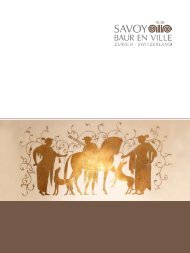You also want an ePaper? Increase the reach of your titles
YUMPU automatically turns print PDFs into web optimized ePapers that Google loves.
Conversations with DonALD BAeCHLer<br />
«Geographical paintings,» Donald Baechler sometimes calls his work, «paintings with origins in other<br />
places, in someone else’s history.» Superimposing associations with foreign cultures onto his paintings, Donald<br />
Baechler does not focus on content or style, but rather seeks to evoke an attitude! «I don’t understand<br />
my paintings,» the artist confesses openly. «It’s not an ideal world. It’s never a world that is full of much of<br />
anything. The faces, the flowers, the characters. Perhaps they are a kind of diagram of isolation, in a way.<br />
It’s like a child locked in a room with one toy.» Thus began my series of conversations with this gentle yet<br />
brilliant individual.<br />
Baechler was born in Hartford, Connecticut, on November 22, 1956. From 1974 to 1977, he studied at the<br />
Maryland Institute of Art in Baltimore, followed by further periods of study at the Cooper Union, New York,<br />
in 1977-78 and at the Städelschule in Frankfurt/Main in 1978-79. He lives and works in New York City. His extensive<br />
portfolio includes paintings, drawings and sculptures that I personally adore. Especially in his many<br />
prints and engravings, Baechler has, with characteristic wit and humor, created a metaphorical language of a<br />
popular culture that has gained him a widely held reputation – almost at the same time as Keith Haring and<br />
Jean-Michel Basquiat – as a second-generation pop artist. Technical versatility is what sets Baechler apart.<br />
In his choice of subjects, he follows a set repertoire, returning repeatedly to specific motifs, but rendering<br />
them in an array of techniques and materials. He treats drawings, paintings and sculpture as independent,<br />
self-contained genres. Baechler works with formal principles filtered out of what he calls collective memory.<br />
Tulips and playing cards, the repeated representation of a fir tree, a potted plant in a childlike formal language…<br />
These are just a few examples of Baechler’s motifs.<br />
His imagination has a history, as yet unwritten, and it has a geography, as yet only dimly visible. There is<br />
no need to describe his studio: the artist’s consciously self-effacing circumstances seem utterly irrelevant.<br />
The very act of creating a painting is kept at arm’s length. You will seldom find Baechler without a pad and a<br />
felt-tip pen, however. At the end of any given evening, he thus returns with pockets full of crude, hastily jotted<br />
sketches. Intriguingly, the artist would seem almost to prefer that other non-artist friends make drawings for<br />
him. «I try to get outside myself as much as possible, outside my habits. I’m interested in different ways of putting<br />
lines together, ways that would never occur to me, that have nothing to do with my own nature, inclination<br />
or training.» Baechler looks for ideas and stimulus outside his own level of perception, looking for inspiration to<br />
his collection of books of Art Brut, children’s drawings, art of the insane, even scrawls on latrine walls – images<br />
alien to all educated tradition. Though he never seeks to portrait his subjects (actually preferring to avoid doing<br />
so), Donald Baechler’s paintings often revolve around one solitary individual, perhaps a surrogate for the artist<br />
himself, set adrift in an intentionally vague, if not enigmatic then certainly unexplained relationship to another<br />
object or objects: an emblematic globe, a ball, a gyroscope, a candle, sometimes the cut-out profile of a tree or<br />
a flower. «Reduced circumstances, to say the least. There is never an intention of likeness,» in his own words.<br />
His work has more to do with setting a stage than depicting a scene, a stage on which the artist’s lexicon<br />
of images makes its appearance. Even so, Baechler openly avows his love of minimalism and of the<br />
conceptual practices of the 1970s. «I have never rejected anything.»<br />
Donald Baechler’s international success is rooted in his very distinctive artistic expression and, as<br />
we saw earlier, his technical versatility. In his latest works, he concentrates on a small number of symbolic<br />
motifs which he features in various forms taken from differing contexts. He uses motifs such as flowers<br />
or fir trees and transforms them using different techniques. His artistic expression reflects traditional genre<br />
boundaries and design patterns, which he then subtly undermines with his creations. Each piece of his work demonstrates<br />
an impressively structured openness while successfully performing a delicate balancing act between<br />
shape and color, tactile presence and reduction.<br />
His latest venture with Wes Lang – «Skulls and Shit» – impresses in another way: It takes considerable visual<br />
intelligence to manipulate an image as clichéd as a skull. Yet Baechler has always maintained a keen aptitude for<br />
rendering what he considers commonplace items. Every generation tends to harbor some apocalyptic scenario<br />
unique to its time and to a given place. So it is no surprise to see Baechler’s skulls sporting halos, slowly coming<br />
into focus as a final reminder that commercial prizes are just another vain denial of a shared mortality.<br />
I asked Donald what makes a great artist. His answer was frank, disarming – and hit the nail on the head: «I think<br />
a good artist, in general, is someone who doubts what he’s doing and looks for ways of doing it better and making<br />
it even more interesting.»<br />
I wonder what he’ll do next?<br />
views magazine | 59



